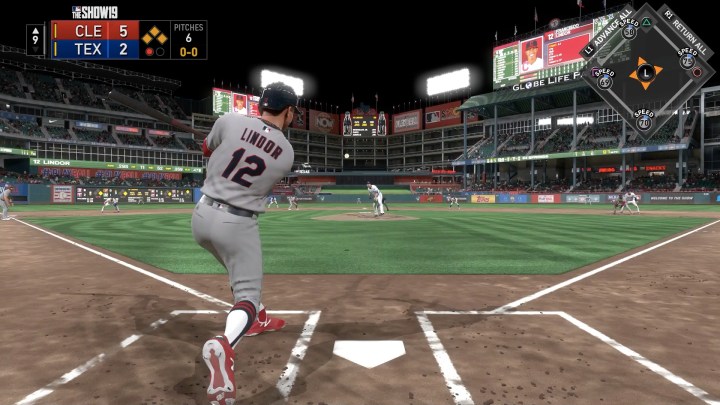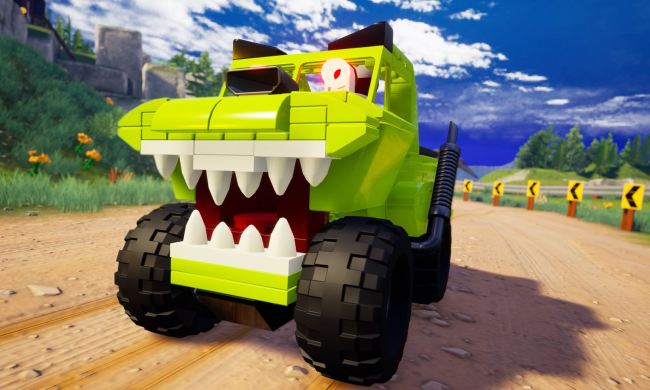
For series veterans, MLB The Show 19 won’t offer much in the way of new batting mechanics. On the offensive side of the plate, things have pretty much remained the same for the past few years. That means that it’s still a pitcher-dominated experience. Racking up hits and scoring runs is authentically challenging, meaning that you cannot just belt every pitch you see over the Green Monster. If you’re new to the series or need a refresher to start off Opening Day on the right note, our batting and base running guide will help you square up pitches and trot around the bases.
Choosing your swing style

There are three core batting control schemes in MLB The Show 19. Finding which one is right for you can be a process of trial and error.
Directional
The default control mode. All you have to worry about here is pressing a button when the pitch crosses the plate. With Directional batting, you have three different swings: Normal (X), Power (Square), and Contact (O). Opinions on the effectiveness of each swing vary, as we’ve hit home runs and dribblers to infielders with each type.
Generally, the normal swing is your best bet here, as it’s the most versatile. Power swing requires you to have better timing to get a good result. Contact is the least demanding. You’ll probably strike the ball more often using Contact, but it’s rarely worth it unless you simply need to get the ball into play to score a run.
Zone
Zone hitting is the most popular control scheme among enthusiasts. It gives you the most control over each plate experience. With Zone hitting, you have to move the PCI (the contact zone) to line up with the path of the ball before pressing the button to swing. Because you have so much control over where you swing the bat, you get better aiming with Zone hitting. Directional is more of a CPU-generated guess, which can lead to some frustrating misses.
If you miss on a sure-fire hit with the Zone control scheme, the blame falls solely on you. Zone is certainly the hardest control scheme to master, but if you plan on playing online or want to play on the higher difficulty levels, you’ll want to learn it eventually.
Pure Analog
Pure analog is our favorite scheme, purely because it feels the most like swinging an actual bat. You don’t have to worry about PCI with Pure analog. Instead, you flick the left joystick forward for a Normal swing and extend it back before flicking forward for a Power swing. Flicking left or right triggers the Contact swing, but again, we don’t recommend using Contact unless you just need to get the ball into play.
Ideally, you can use Pure Analog to get a feel for the flow of the game before switching to Zone if you want to play online. You can absolutely achieve great results against the CPU sticking with Pure Analog indefinitely, but just know that users you play online will likely be playing with Zone hitting, giving them a bit of an advantage (or a huge advantage if they’re very good).
Getting a read on the pitch

The Show is a strict simulation experience, which means you need to be patient in the batter’s box. Unlike older, arcade baseball games, you have to really sit on the pitch before swinging (or not swinging). Timing is everything, and with every swing, you’ll see a popup displaying how well you timed it (from very late/early to good) along with the contact result. The goal is to “square up” each pitch with good timing. But before being able to do that, you have to learn each pitcher’s tendencies.
Pitchers have unique animations that reflect their real-life throwing motions. The timing for each one is different, so you’ll have to pay attention to where they release the ball from their hand. After that, it’s your job to follow and examine the pitch in less than a second. Sounds incredibly challenging, right? It makes you appreciate what the pros do in real life.
At first, it can be quite challenging to get a feel for balls and strikes. Pitchers have three, four, sometimes even five different pitches in their arsenal. They range from heaters like four seam and two seam fastballs to off-speed pitches like changeups, curveballs, and splitters. The difference in speed and movement can be profound from pitch to pitch.
After a while, however, you’ll start to recognize pitches almost directly after they are thrown. You’ll see the almost slow-motion movement of the changeup, or the blur of the fastball, or the sink and curve of a breaking ball. Based on its initial location, it becomes almost second nature to know if the ball will be in the zone or not as it crosses the plate.
Try to work into hitter’s counts

A hitter’s count is when you have the pitcher on his heels with a 2-0 or 3-1 count. When you get into these situations, where there are more multiple more Balls than Strikes on the scoreboard, you’re likely to see more pitches come in over the plate. This can lead to great opportunities for power swings, as well as giving you room to wait for the pitch placement that you excel at. Whether that be high in the zone or low.
For this reason, we suggest to almost always sit on the first pitch. The only exception to this rule is when the ball is perfectly placed over the center of the plate. Swinging too early can lead to quick outs. Part of the goal throughout a game is to tire the starter pitcher. You can’t do that if you don’t have prolonged at bats.
Also, remember what your Little League coach told you: Walks are as good as hits. They really are.
Getting down in the count early (0-2, 1-2) gives the pitcher a might advantage. Both CPU and user-controlled pitchers will likely try to get you to chase outside of the zone on subsequent pitches. Because you’re down in the count, you might be a bit antsier and less careful with your swing decisions.
Base running

Unless you’re only hitting dingers, you’ll have to worry about scoring your runners once they get on base. Getting a consistent streak of singles will bring runners home without having to do much, but often you have to make risky decisions on advancing runners further than they do automatically.
Tagging up
Tagging up is the act of advancing a runner after a fly ball is caught in the outfield. This is a judgment call based on where the out is made and which bases your runners are on. Generally, it’s not worth the risk to tag up from first base unless the out is made near the warning track or deep in center field. Tagging from second to third is almost always worth it when the out is made in right field and deep in center field, but rarely smart when the left fielder makes the play.
Tagging up from third to home should be done if the out is made anywhere besides shallow center. The only exception is if you have a very slow player on third. Player speed is shown on their icon once they reach base.
Stealing is tough
Stealing bases is pretty dang difficult. Even below average catchers make great, fast throws, so it’s easy to get caught stealing. You can take a few additional steps away from the bag by pressing L1 (if you’re feeling dangerous, you can take an even larger lead). Beware that pitchers may try to pick your runners off while taking leads. It’s not hard to get back to the bag on time, but if you’re not paying close attention, it can happen.
Here’s a general rule to follow. Rarely, if ever, try to steal third. Only try to steal second when you have a speedy runner on first, and absolutely never try to steal home. Unless there’s a wild pitch, you aren’t going to make it home safely.
If you have runners on first and third and less than two outs, however, you can typically steal a base for free. Simply send the runner to second. If your opponent is smart, they won’t even make the throw. If they do make the throw, your runner on third will have an open and easy lane to home.
Hit-and-run
Conversely, stealing when you know you’re going to make contact with the pitch does make sense. Called a hit-and-run, it’s beneficial to do this when you’re worried about hitting into a double play or when you’re trying to advance a runner from second to third or third to home without getting on base. Even a ground ball to the infield will advance a runner on a hit-and-run, especially if there isn’t a force out available.
Runners in scoring position
When you have a runner on third, they should make it home on any hit into the outfield. When a runner is on second, you can be aggressive and make it home on almost any routine single into the outfield. The only scenario where it’s hard to advance from second to home is on hard-hit line drives that reach the outfielder on one or two hops. If the fielder gets the ball in his glove before you touch third base, it’s best to sit at third rather than risking getting thrown out at home.


